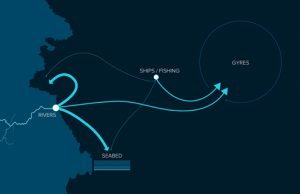The Flotsam of Life

Whilst on a dive holiday at the age of 16, Boyan Slat was scuba diving in Greece and was troubled by the fact he was seeing “more” plastic bags than fish. Why can’t we just clean this up?
As a high school science project he decided to try and find a solution. Many people told him this would fail and it was a job “too big” to do anything about. Thankfully with the wisdom of youth, this did not deter Boyan.
He enrolled in University to study Aerospace Engineering but had the Ocean constantly on his mind. Such was the impression made, Boyan decided to “dropout” and focus on finding a solution for the Ocean. His reasoning sound enough for his parents to agree.
Boyans’ reasoning about this “impossible, high risk task” was simple. If you don’t try then there is clearly no chance, so try he did.
His limited savings were used to create a business model and all went on setting up the business structure, he then set about seeking funding by writing to numerous companies. The single response he received said basically: “It was a terrible idea and he should go back to school as it would never work.”
Disappointing as this was, it did not deter his focus. Seeking funds via crowdfunding in 2014, “Ocean Cleanup” proved to be the largest backing of its time.
Much has been publicised about the incredible amount of human waste that has moved to our oceans with not much about solutions.
There have been many detractors and hiccups along the way, but given the alternative of “nothing” it is hard not to feel admiration for anyone willing to try.
Ideal outcome was to create a solution that would passively continue to cleanup debris:
Due to Ocean currents, there are five Ocean regions where the plastic debris forms mass plastic waste islands that are known as a Gyre
- The North Pacific Gyre
- The South Pacific Gyre
- The South Atlantic Gyre
- The Indian Ocean Gyre
- The North Atlantic Gyre
Each piece of plastic waste that gets swept or flows to the Ocean will either sink or be drawn via currents and end up in one of these very large areas where waste is drawn via currents *or eaten or entangled in Marine life causing its demise. These areas of high density waste have been given the term “Great Garbage Patch” by the Ocean Cleanup. Contrary to what some folks perceive as it being an Island, it is an accumulation zone that covers 1.6 million km2
In 2015 a data/fact finding study was undertaken by Ocean Cleanup to quantify the magnitude of the problem – it involved 30 vessels and aircraft surveys in 2016 :
Modelling that was used incorporating Ocean catch and finds determined that:
Over 1 million pieces of debris were collected weighing 668 kilograms and were made up of 99.9% plastic, with a significant portion (45%) belonging to “ghost nets” (discarded or broken fishing and trawler netting. This netting floats through the Ocean continuing to do exactly what it was intended for – trapping Marine life. With smaller breaks “micro plastics” consumed by Marine Life and by extension into our food chain).
Identifying via this physical study in the proximity of one Gyre only, that nearly half of the plastic debris is “fishing related” rather than land based waste.
The Ocean Cleanup estimates it will take 20 years to rid the Ocean of the waste that is there.
There have been 4 released versions:
- 2016 First prototype
- 2017
- 2018 A giant structural tube like affair named “Wilson” designed to entrap floating Ocean debris. Wilson did not work in harmony with the ebb and flow of the ocean. Unfortunately within eight weeks, it was obvious the design was flawed with waste now spilling back into the Ocean and satellite issues. The design flaw was identified and two young interns working on the project asked about a float option, this has now been integrated. During System 001’s first mission, 2000kg of plastic was collected.
- 2019 moved to a free floated design – (rather than tethering to the Ocean floor, a massive task fraught with all the major ongoing issues and costs to stay in operation)
In June 2019 The Ocean Cleanup has now moved a new version out once again to Sea for testing.
As the team is based on scientific research there are often outcries from those who await a result. With somewhere in the vicinity of 35 million dollars being raised by crowdfunding, Research and several years later not much in the way of debris being removed. People are asking when will it happen? It is all well and good to study and survey, but meanwhile marine life is at stake.
The Ocean Cleanup has partnered with a number of business and corporate structures.
Due to territorial restrictions The Ocean Cleanup Crew operate in their zone, another reason we actually need many more of these operations to fix the waste that is already in the Great Seas and find a way for the fishing fraternity to secure its waste and stop land sources entering the sea in the first place.
Any way you look at it, there is years of work to repair the damage already caused.
Out of Sight is Out of Mind



